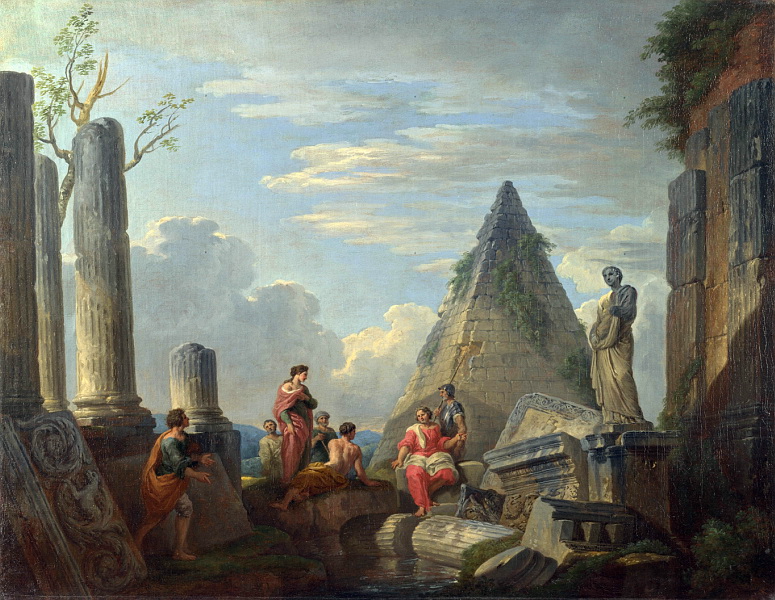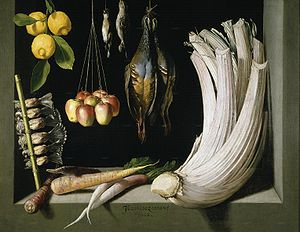
- •Answer the following questions. Be explicit:
- •Think over the following questions, looking at a painting: Reading a painting: general questions
- •Study the following text:
- •How to Read a Painting - 1
- •How to Read a Painting - 2
- •Study the following information: some styles of painting:
- •Find additional information about different painting styles: a list of the styles of painting:
- •Study the information on painting types. Look at some of the reproductions: Types (Genres) of Painting
- •Examples of Famous Paintings In All Genres
- •Portraiture Genre
- •Genre-Paintings
- •Landscape Genre
- •Still Life
- •Analyzing portraits:
- •Leonardo da Vinci. Mona Lisa (Gioconda)
- •"The Morning Walk" by Th. Gainsborough
- •Analyzing landscapes:
- •«Тайная вечеря»
- •In front of the painting ‘Boyarina Morozova’
Landscape Genre
Derived from the Dutch word 'landschap', a patch of ground - the term 'landscape' denotes any picture whose main subject is the depiction of a scenic view, such as fields, hillscapes, mountain-scapes, trees, riverscapes, forests, sea views and seascapes. Many famous landscape paintings include human figures, but their presence should be a secondary element in the composition. See also Plein-air Painting.
Following on from the English School of landscape painting 18th/19th century, famous styles include the Barbizon School of Landscape Painting, near Fontainebleu in France, the Wanderers Art Movement in Russia, and of course the supreme exponents of plein-air art The French Impressionist School of Landscape Painting. For details of landscape art in Ireland, see Irish Landscape Artists.
Famous Landscapes:
|
Giovanni Panini: Ruins with Figures |
Bernardo Bellotto: View of Warsaw from the Royal Castle (1772);
Giovanni Panini: Ruins with Figures;
Thomas Girtin: The White House Chelsea (1799);
John Sell Cotman: Chirk Aquaduct (1804);
Caspar David Friedrich: Winter Landscape (1811);
John Constable: Boat-building Near Flatford Mill (1815);
JMW Turner: Hannibal and His Army Crossing the Alps (1812);
Thomas Cole: Last of the Mohicans (series) (1826);
JMW Turner: The Burning of the Houses of Lords and Commons (1835);
Theodore Rousseau: Sunset in the Auvergne (1830);
Frederic Edwin Church: The Heart of the Andes (1859);
Jean-Baptiste-Camille Corot: Ville d'Avray (1875);
James McNeil Whistler: Harmony in Grey - Chelsea in Ice (1864);
Claude Monet: Impression Sunrise (1873);
Alfred Sisley: Snow at Louveciennes (1878);
Pierre-Auguste Renoir: The Bridge of the Railway at Chatou (1881);
Camille Pissaro: Landscape at Chaponval (1880);
Vincent Van Gogh: Wheat Field with Crows (1890);
Isaac Levitan: Secluded Monastery (1890);
Claude Monet: Water Lilies (1908);
Cezanne: Montagne Sainte-Victoire with Trees and a House;
Alexei von Jawlensky: Landscape, Murnau (1909);
Oskar Kokoschka: View of the Thames in the Evening (1926);
Max Ernst: The Entire City (1935);
Ben Nicholson: St Ives, Cornwall (1943-45).
Still Life
A 'still life’ typically comprises an arrangement of objects (such as flowers or any group of mundane objects) laid out on a table. It derives from the Dutch word 'Stilleven', a term used by Dutch artists to describe pictures previously entitled 'Fruit' or 'Flower Pieces'. Still life that contain ethical messages concerning human behaviour, are known as Vanitas paintings.
Famous Still Life Pictures:
|
Juan Sanchez Cotan: Still Life with Game Fowl |
Juan Sanchez Cotan: Still Life with Game Fowl (c.1602);
Frans Snyders: Pantry Scene with a Page (c.1617);
Francisco de Zurbaran: Still Life with Lemons, Orange and a Rose (1633);
Pieter Claesz: A Vanitas Still Life (1645);
Willem Kalf: Still Life with Lobster, Drinking Horn and Glasses (c.1653);
Samuel Hoogstraten: The Slippers (1654);
Harmen Steenwyck: The Vanities of Human Life (1645);
Jan Davidsz de Heem: Still Life of Fruit (1670);
Rachel Ruysch: Flowers and Insects (1711);
Jean-Simeon Chardin: Still Life with Bottle of Olives (1760);
Theodore Gericault: Anatomical Pieces (1818);
Paul Cezanne: Pears on a Chair (1882);
Van Gogh: Sunflowers (1888);
Henri Fantin-Latour: White and Pink Roses (1890);
Emil Nolde: Red Poppies (1920);
Georges Braque: Studio V (1949);
Giorgio Morandi: Still Life (1960).


